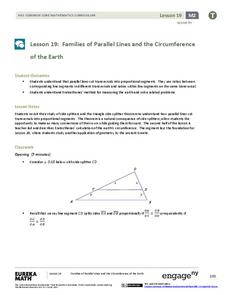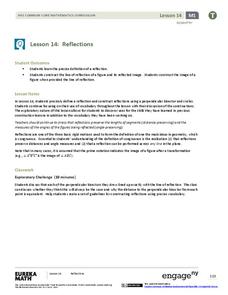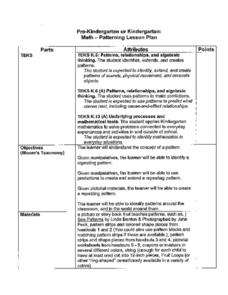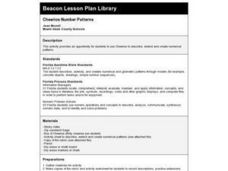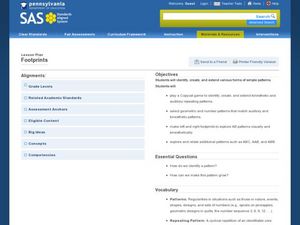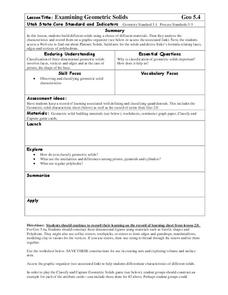EngageNY
Families of Parallel Lines and the Circumference of the Earth
How do you fit a tape measure around the Earth? No need if you know a little geometry! Pupils begin by extending their understanding of the Side Splitter Theorem to a transversal cut by parallel lines. Once they identify the proportional...
EngageNY
Rotations, Reflections, and Symmetry
Lead your high school class on a journey through the world of symmetry and reflections as you discuss geometric principles. Pupils differentiate between reflections and rotations, explore rotational symmetry, and investigate how to...
EngageNY
Reflections
Facilitate creativity in your math class as individuals learn the definition of a geometric reflection and correctly construct a model, as well as its reflected image. They use a perpendicular bisector and circles to elaborate on...
EngageNY
Unknown Angle Proofs—Proofs with Constructions
Provide your emerging mathematicians with the tools to learn as they incorporate auxiliary lines to solve unknown angle proofs in this continuing segment. They decipher information from a diagram to uncover the missing pieces and...
EngageNY
Algebraic Expressions—The Distributive Property
Do your classes truly understand the distributive property? Use a demonstrative lesson to represent the distributive property in various ways. Learners solidify understanding by creating a geometric pattern for distributive property, and...
Kids Can Have Fun
Cut and Paste Shapes
Engage youngsters in exploring the wonderful world of shapes with this series of cut-and-paste activities. Offering a variety of materials from printable pattern blocks to a series of matching exercises, this resource will have your...
Resources for Early Childhood
Making Math Meaningful and Enjoyable
Your young learners will enjoy mathematics that is meaningful correspondence as they play their way to a deep mathematical foundation. Organized around the math standards, this appropriate sequence of conceptual, preschool...
Curated OER
Patterning Lesson Plan
Open the eyes of young mathematicians to the patterns that are found everywhere in the world around them. After a shared reading of I See Patterns by Linda Benton, children complete a series of hands-on activities that teach them how to...
One Billion
Math, Age 3-5
Jump start children's math education with this fun basic skills resource. Offering dozens of different touch-and-swipe activities with colorful graphics, this program is perfect for all young learners.
Curated OER
Seeing Dots
Your algebra learners interpret algebraic expressions, in order to compare their structures, using a geometric context. They also discern how the two expressions are equivalent and represent a pattern geometrically and algebraically.
Sargent Art
Color Value Study
I love geometric art because it applies mathematical reasoning to an artistic endeavor. Creative kids use scale values to highlight their complex, repetitive, geometric designs. Symmetry, angles, and congruence are three concepts that...
Curated OER
Extending Geometric Patterns
Which square comes next? Each of these sequences is made up of patterned squares in a continuing order. Learners examine more squares to choose which one(s) would correctly continue the pattern. None of these have very complex sequences;...
Curated OER
Matchstick Math: Using Manipulatives to Model Linear, Quadratic, and Exponential Functions
Playing with matches (unlit, of course) becomes an engaging learning experience in this fun instructional unit. Teach pupils how to apply properties of exponential functions to solve problems. They differentiate between quadratic and...
Curated OER
Middle-East Reflections
Practice symmetry and patterns with this Mid-Eastern art project. Your class will create beautiful, reflective mosaics that will brighten up the classroom! A list of necessary materials is included.
Virginia Department of Education
Relationships Round Robin
Mathematics is all about patterns. Young mathematicians analyze geometric patterns to write algebraic expressions. They use the expressions to predict future stages of the patterns.
National Gallery of Canada
Counting Circles
Learners look at bands of colors and estimate how many rings of color there are. While working in groups, they come up with a plan of how to accurately count the rings. They attempt to find a pattern in the colors, and decide whether...
Curated OER
Cheerios Number Patterns
Young scholars, following a provided worksheet, use Cheerios to explore number patterns.
Curated OER
Patterns Everywhere!
Learners recognize and demonstrate the patterning of numbers and objects in our environment. They create a pattern using geometric shapes and find a missing number in a sequence.
Curated OER
Mosaic Tiles
I would consider this an outline and not a complete lesson. It would take a little work on your part because you would need to look on the internet for examples of Ojibwe art to show your pupils. They could explore the patterns that the...
Curated OER
Eating Patterns
Students sort through pictures of food to create patterns as they pertain to geometry. For this geometric patterns lesson, students relate to food as concrete objects that represent geometric patterns. Students recognize and describe the...
Curated OER
Circles and Parabolas
In this circles and parabolas worksheet, students follow directions to draw parabolas. They fold paper to represent a parabola. Students also use straight lines to create a circle. This one page worksheet contains three multi-step...
Curated OER
Footprints
Students explore patterns. In this patterns geometry lesson, students identify and extend patterns including body parts, movement, geometric shapes, noises, and footprints. Students create and share an original pattern.
Curated OER
Complete the Patterns
In this pattern completion worksheet, students observe groups of six patterns and add the final two patterns. Students complete five sets of patterns.
Curated OER
Examining Geometric Solids
Students explore geometry by completing a math worksheet in class. In this shape identification lesson, students identify the characteristics associated with 15 solid geometric shapes. Students identify patterns between vertices, edges...


